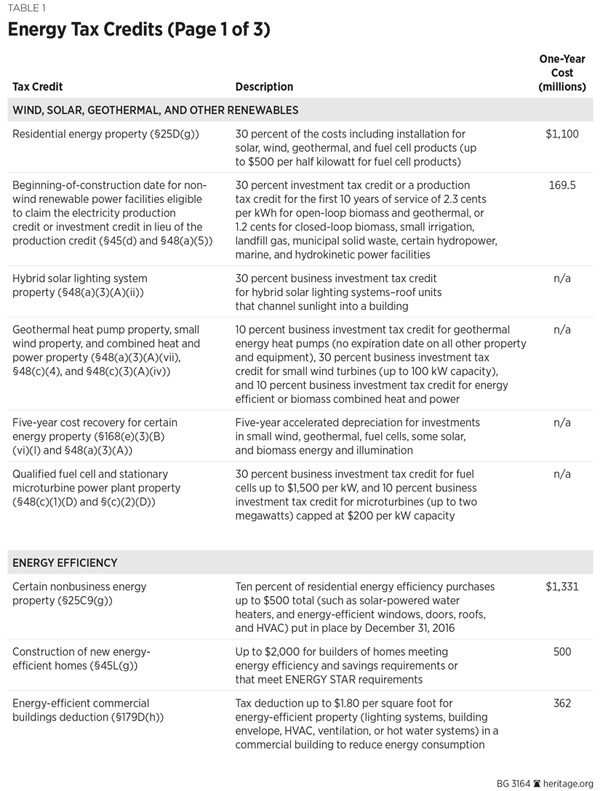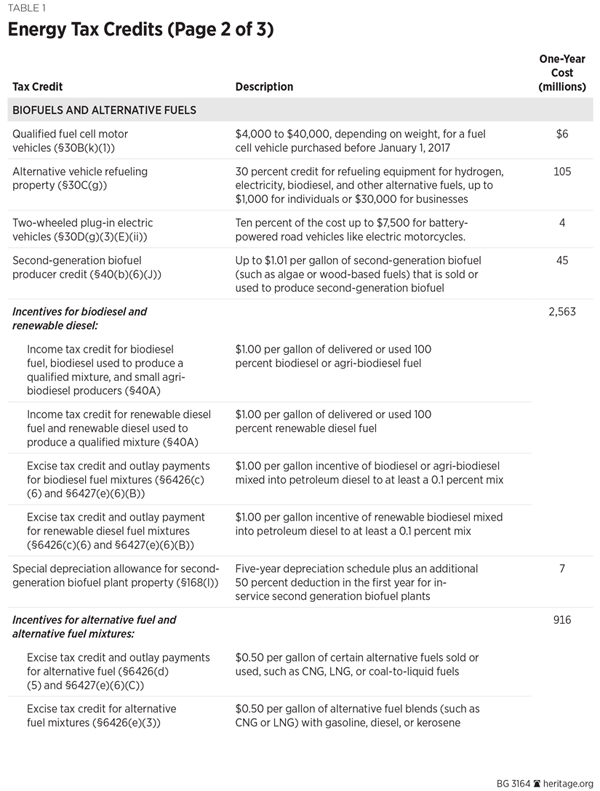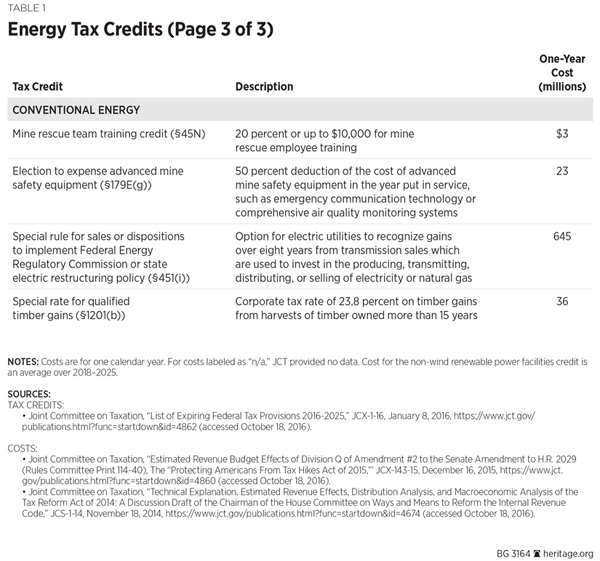Two dozen technology-specific, energy-related tax provisions expire at the end of 2016, including subsidies in the form of tax credits for coal, natural gas, renewable energy, and energy efficiency.[1] By transferring the tax burden from these politically connected industries to everyday Americans, Washington is not only increasing unfairness in the tax code but also distorting the marketplace, which results in economic inefficiency and technological stagnation.
Instead of addressing each tax provision on its own merits, Congress has traditionally manufactured crises around deadline events, such as the close of the fiscal year, to justify moving all the provisions forward in one package of tax extenders.[2] A better approach would be to simply allow the credits to expire and thus prevent the diversion of tens of billions of taxpayer dollars to energy companies that cater more to the preferences of politicians, academics, and special interests than to the needs of the marketplace.[3]
However, not all of the tax policies currently under consideration are bad policies. Those that lower the tax burden generally for all industries should be extended or made permanent. For example, absent a reform to establish immediate expensing for all capital investment, provisions for accelerated depreciation schedules should be extended. Ultimately, Congress should pursue tax reform that lowers rates broadly and avoid using the tax code to pick winners and losers. Doing so is best for the energy sector to realize its potential and to grow the economy broadly.
Tax Credits Expiring at the End of 2016
Using the tax code to encourage energy development dates back more than a century. Even the tax credits for so-called emerging technologies and energy sources are several decades old.[4] For instance, Congress first enacted the wind production tax credit in 1992 and the solar investment tax credit, as it is known today, in 2005, although similar solar tax credits go back to 1978. Congress is also discussing whether to extend tax credits for hybrid solar lighting systems, fuel cells, geothermal, biomass, combined heat and power systems, and small wind power. Extension proponents claim that the subsidies were mistakenly left out of last year’s tax extenders bill, which included five-year extensions and expansion of the wind production tax credit and solar investment tax credit. Regardless of whether the omission of these subsidies was intentional, it was a small piece of good news for the tax code, the American people, and free enterprise, as the government’s use of the tax code to pick winners and losers has many harmful economic effects on American families and businesses. Table 1 shows the energy-related tax credits set to expire at the end of the year. If renewed for another year, these credits would divert at least $7.8 billion in tax dollars. Subsidies do not make energy resources and technology less expensive; they just make more people—namely, taxpayers—pay for them.
Energy Markets Are Diverse and Competitive Without Special Government Treatment
The U.S. already has a diverse, competitive energy market to meet its energy needs. The market currently includes coal, oil, natural gas, nuclear, hydroelectric, wind, solar, biofuels, battery, and geothermal power. Ample opportunity exists for new, innovative technologies to enter the market. Each year Americans collectively spend hundreds of billions of dollars on energy needs. Combining residential and transportation expenditures, energy expenditures per person exceeded $3,000 in 2012.[5] The market incentive to supply affordable electricity or a competitive transportation fuel is enough to spur private investment without any preferential treatment from the federal government.
Using the tax code to drive energy revolutions ignores how energy markets really work. As prices change, so does private investment. With gas price fluctuation, for instance, private investments can develop an economically viable alternative to the internal combustion engine, such as electric vehicles, or new sources of a transportation fuel may emerge, like biofuels or natural gas. Increase in prices also incentivizes increased oil production.
The dynamic flow of investments and consumer behavior is best determined by the marketplace, not politicians trying to predict or outsmart the market. Private companies will make investments with better foresight than the government, whose policies are typically reactionary. In terms of energy policy and the energy market, the government’s role should be limited to opening access to resource development, reducing the regulatory burden for all energy sources, and eliminating all forms of preferential treatment.
Tax Credits Distort Energy Markets
Tax credits for specific technologies distort energy markets. For example, the wind production tax credit Congress extended again last year enables wind-electricity producers to pay distributors to take their electricity and yet still make a profit. When selling the electricity to grid operators, the producers can underbid other electricity producers in times of excess supply because wind-electricity producers can depend on $22 per megawatt hour generated from the tax credit.
The tax credits have adverse impacts on the electricity sector in both the near and long term. In the near term, electricity markets are skewed to prioritize subsidized wind over other resources that may provide more reliable, efficient, and dispatchable electricity to consumers. Because wind and solar are intermittent sources of energy, integrating them into the grid is difficult and costly for power grid operators, who are constantly trying to balance supply and demand. In the intermediate to long run, the tax credits undercut electricity markets, making it difficult for otherwise affordable and reliable nuclear, coal, or natural gas power plants in particular to compete.
In fact, several successful nuclear power plants have closed in recent months even as years remain on their operating licenses. Although a number of factors are at play in these closures, including inexpensive natural gas,[6] state and federal subsidies to renewables in particular have spread the costs of wind and solar power across all taxpayers with the unintended consequence of making other long-term investments in resources like nuclear power unaffordable.
Tax Credits Invite Government Interference and Foster Government Dependence
The government’s use of the tax code to promote one technology over another distorts private-sector investments. Private capital is limited. Technologies that do not receive subsidies appear more expensive, risky, or unpromising. In shifting the financial risk of energy projects through the tax code, the government is discouraging private investments in projects that lack the government’s blessing but may have more commercial promise. A dollar invested in a company benefiting from a tax credit cannot simultaneously be invested in another company, creating opportunity costs where potentially promising but unsubsidized technologies may not receive investment.
Moreover, targeted tax credits provide one technology a government-created price advantage over a non-credited competing technology. Companies that do not receive any preferential treatment consequently will lobby for one, demanding a level playing field. The end result is a hodgepodge of tax credits that benefit select technologies that Members of Congress support because it particularly benefits their district or state. The only way to actually level the playing field is to eliminate all sources of subsidies for all forms of energy.
Further, a business model built around taxpayer-funded subsidies distorts the incentives that drive innovation. Preferential tax treatment reduces the necessity for an industry to make its technology cost-competitive because the tax credit shields a company from recognizing the actual price at which its technology is economically viable. Less competitive companies make up part of an artificially inflated industry which shrinks according to actual market demand once a tax credit expires, as evidenced when the wind production tax credit expired several times.[7] For profitable companies, a tax credit only serves to pad their bottom line. Even if a company does not claim the need for more tax credits, its refusal to accept them would put it at a competitive disadvantage.[8] As a result, an industry is pulled down to the lowest common denominator and tax credits promised to only last a few years to get an emerging technology off the ground become a permanent part of the tax code.
If Alternative Energy Technologies Are Competitive, Why Is Special Treatment Necessary?
Those who advocate a shift away from using hydrocarbons often argue that renewable technologies are cost-competitive. In fact, the Department of Energy recently published several charts that show the costs of wind, solar, and electric vehicles, as well as light emitting diodes (LEDs), as “becoming increasingly cost competitive” with conventional fuels.[9] Consumers have been told this for well over two decades.[10] However, if alternative energy sources are cost-effective, they should not need help from the federal government to enter the market.
Similarly, champions of energy-efficiency mandates, regulations, and subsidies claim that families and businesses will save money by installing more energy-efficient windows, using energy-saving building materials, or buying more energy-efficient appliances. Families and businesses will make energy-saving investments without government-provided incentives, because when the savings outweigh the costs, families secure reduced energy bills and businesses gain a competitive advantage.[11]
Make Immediate Expensing Permanent for All Investment
Unlike targeted tax credits, some pro-growth tax policies do reward economic growth in a neutral way. Two policies—expensing and depreciation—are properly addressing all capital expenditures with immediate expensing and shorter depreciation schedules until full expensing becomes permanent.
- Immediate expensing allows companies to deduct the cost of capital purchases at the time they occur rather than deducting that cost over many years based on cumbersome depreciation schedules.
- Immediate expensing for all new plant and equipment costs—for any industry or type of equipment—would allow newer equipment to come online faster, which would improve energy efficiency and overall economic efficiency.
- Depreciation raises the cost of capital and discourages companies from hiring new workers and increasing wages for existing employees.
- Shorter depreciation schedules permit businesses to recover the costs of capital sooner, although Congress should replace depreciation schedules with immediate expensing provisions to optimize investment without meddling with the tax code.
President Obama has championed temporary 100 percent immediate expensing for qualified capital because it reduces the tax bias against investment.[12] Congress should make immediate full expensing permanently available for all business investments. Until that takes effect, Congress should retain all provisions that move the tax code in the direction of expensing.
Allowing Energy Credits to Expire Is a Step in the Right Direction
Simply doing nothing and allowing the energy-related tax credits to expire at the end of the year will take energy policy and the tax code in the right direction. When politics are removed from the equation, American businesses and families are free to make the energy choices that best suit their needs. Congress should eliminate all targeted tax credits for all energy sources, including hydrocarbons and nuclear, and enable free enterprise to drive energy investments.
—Nicolas D. Loris is Herbert and Joyce Morgan Research Fellow and Katie Tubb is a Policy Analyst in the Thomas A. Roe Institute for Economic Policy Studies, of the Institute for Economic Freedom and Opportunity at The Heritage Foundation.






